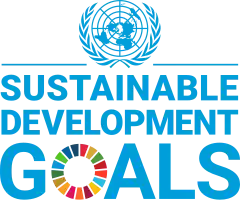Sustainable Development Goal 12
Sustainable Development Goal 12 (SDG 12 or Global Goal 12) is about "responsible consumption and production". It is one of the 17 Sustainable Development Goals established by the United Nations in 2015. The official wording of SDG 12 is "To ensure sustainable consumption and production patterns".[1] SDG 12 is meant to ensure good use of resources, improving energy efficiency, sustainable infrastructure, and providing access to basic services, green and decent jobs and ensuring a better quality of life for all.[2] SDG 12 has 11 targets to be achieved by at least 2030 and progress toward the targets is measured using 13 indicators.[3]
| Sustainable Development Goal 12 | |
|---|---|
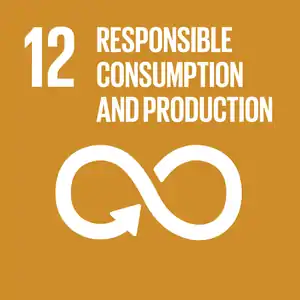 | |
| Mission statement | "Ensure sustainable consumption and production patterns" |
| Commercial? | No |
| Type of project | Non-Profit |
| Location | Global |
| Owner | Supported by United Nation & Owned by community |
| Founder | United Nations |
| Established | 2015 |
| Website | sdgs |
The 11 targets of the goal are: implement the 10‑Year Framework of Programs on Sustainable Consumption and Production Patterns; achieve the sustainable management and efficient use of natural resources; reducing by half the per capita global food waste at the retail and consumer levels; achieving the environmentally sound management of chemicals and all wastes throughout their life cycle; reducing waste generation through prevention, reduction, recycling and reuse; encourage companies to adopt sustainable practices; promote public procurement practices that are sustainable; and ensure that people everywhere have the relevant information and awareness for sustainable development. The three "means of achieving" targets are: support developing countries to strengthen their scientific and technological capacity; develop and implement tools to monitor sustainable development impacts; and remove market distortions, like fossil-fuel subsidies, that encourage wasteful consumption.[4]
By 2019, 79 countries and the European Union have reported on at least one national policy instrument to promote sustainable consumption and production patterns. This was done to work towards the implementation of the "10-Year Framework of Programmes on Sustainable Consumption and Production Patterns".[5]:14 Global fossil fuel subsidies in 2018 were $400 billion. This was double the estimated subsidies for renewables and is detrimental to the task of reducing global carbon dioxide emissions.[5]:14
The targets of Goal 12 include using eco-friendly production methods and reducing the amount of waste. By 2030, national recycling rates should increase, as measured in tons of material recycled. Further, companies should adopt sustainable practices and publish sustainability reports.
Background
Consumption and production are termed as a driving source of the global economy. However, they also rest solely on the use of the natural environment and resources in a way that it continues to have adverse effects on the planet. According to the United Nations Environment Programme (UNEP), integrating environmental sustainability and economic growth still remains a major global challenge to date. Economic and social progress over the last century has been accompanied by environmental degradation that is damaging the very systems on which our future depends.[6]
To achieve economic growth and sustainable development, it requires that we urgently reduce our ecological footprint of usage by changing the production and consumption of goods and resources. Agriculture is the largest user of water worldwide, and irrigation now claims close to 70 percent of all freshwater for human use.[7]
Targets, indicators and progress
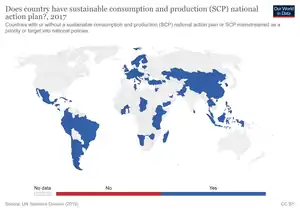
SDG 12 has 11 targets. Four of them are to be achieved by the year 2030, one by the year 2020, and six have no target years. The targets address different issues ranging from implementing the 10‑Year Framework of Programmes on Sustainable Consumption and Production Patterns (Target 12.1), achieving the sustainable management and efficient use of natural resources (Target 12.2), having per capita global food waste at the retail and consumer levels (Target 12.3), achieving the environmentally sound management of chemicals and all wastes throughout their life cycle (Target 12.4), substantially reduce waste generation through prevention, reduction, recycling and reuse (Target 12.5), encourage companies to adopt sustainable practices (Target 12.6), promote public procurement practices that are sustainable, in accordance with national policies and priorities (Target 12.7), ensure that people everywhere have the relevant information and awareness for sustainable development (12.8), support developing countries to strengthen their scientific and technological capabilities (Target 12.a), develop and implement tools to monitor sustainable development impacts for sustainable grouwth (Target 12.b), rationalize inefficient fossil-fuel subsidies that encourage wasteful consumption by removing market distortions (Target 12.c).
Target 12.1: Implement the 10-year sustainable consumption and production framework
The full title of Target 12.1 is: “Implement the 10‑Year Framework of Programmes on Sustainable Consumption and Production Patterns, all countries taking action, with developed countries taking the lead, taking into account the development and capabilities of developing countries".[8] The goal of this SDG is to have all countries taking the action by 2030.
It has one indicator: Indicator 12.1.1 is the "Number of countries with sustainable consumption and production (SCP) national action plans or SCP mainstreamed as a priority or a target into national policies".[9]
This indicator allows for the quantification and monitoring of countries making progress along the policy cycle of binding and non-binding policy instruments aimed at supporting Sustainable Consumption and Production. Mainstreaming sustainable consumption and production in decision-making at all levels is a core function of the 10-Year Framework. It is expected to “support the integration of sustainable consumption and production into sustainable development policies, programmes and strategies, as appropriate, including, where applicable, into poverty reduction strategies”[10] Suitable data resources for this indicator are currently being explored because statistical standards are yet available.
This framework, adopted by member states at the United Nations Conference on Sustainable Development, is a global commitment to accelerate the shift to sustainable consumption and production in developed and developing countries.[11] In order to generate the collective impact necessary for such a shift, programs such as the One Planet Network have formed different implementation methods to help achieve Goal 12.[12]
By 2019, 79 countries and the European Union have reported on at least one national policy instrument to promote sustainable consumption and production patterns.[5]:14 This was done to work towards the implementation of the "10-Year Framework of Programmes on Sustainable Consumption and Production Patterns".[5]:14
Target 12.2: Sustainable management and use of natural resources
The full title of Target 12.2 is: "By 2030, achieve the sustainable management and efficient use of natural resources."[1]
This target has two indicators:[13]
- Indicator 12.2.1: Material footprint, material footprint per capita, and material footprint per GDP
- Indicator 12.2.2: Domestic material consumption, domestic material consumption per capita, and domestic material consumption per GDP
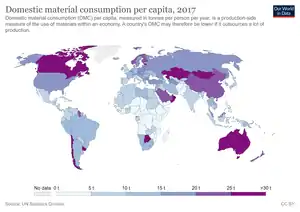 World map related to Indicator 12.2.2 in 2017. The map shows domestic material consumption, domestic material consumption per capita, and domestic material consumption per GDP.[2]
World map related to Indicator 12.2.2 in 2017. The map shows domestic material consumption, domestic material consumption per capita, and domestic material consumption per GDP.[2]
Material Footprint is the quantity of material extraction that is required to meet the consumption of a country. The sum of material footprint for biomass, fossil fuels, metal ores and non-metal ores is called the total material footprint.[2] Domestic Material Consumption (DMC) is a production-side measure which does not account for supply chain inputs or exports, meaning a country could have a lower DMC value if it outsources a large proportion of its materials.[2]
A report by the UN in 2020 found that: "Global domestic material consumption per capita rose by 7 per cent, from 10.8 metric tons per capita in 2010 to 11.7 metric tons in 2017, with increases in all regions except Northern America and Africa."[5]:14
Also, the global material footprint was 85.9 billion metric tons in 2017. This was a 67 per cent increase from 2000.[5]:14
Target 12.3: Halve global per capita food waste
The full title of Target 12.3 is: "By 2030, halve per capita global food waste at the retail and consumer levels and reduce food losses along production and supply chains, including post-harvest losses.".[1][2] This target has two components (losses and waste) measured by two indicators.[14]
- Indicator 12.3.1.a: Food Loss Index which focuses on losses from production to consumption level
- Indicator 12.3.1.b: Food Waste Index this indicator is a proposal under development with the UN Environment taking lead on it
There is currently no data available for this indicator as of September 2020.[2]
Target 12.4: Responsible management of chemicals and waste
The full title of Target 12.4 is: "By 2020, achieve the environmentally sound management of chemicals and all wastes throughout their life cycle, in accordance with agreed international frameworks, and significantly reduce their release to air, water and soil in order to minimize their adverse impacts on human health and the environment"[1]
This target has two indicators:[13]
- Indicator 12.4.1: Number of parties to international multilateral environmental agreements on hazardous waste, and other chemicals that meet their commitments and obligations in transmitting information as required by each relevant agreement
- Indicator 12.4.2: (a) Hazardous waste generated per capita; and (b) proportion of hazardous waste treated, by type of treatment
The Indicator 12.4.1, doesn't measure the quantity or the impact on the health of chemicals. It is instead referred to the number of countries that have ratified, accepted approved or accesses to one of the follow Multilateral Environmental Agreements:[15]
In the case of the Indicator 12.4.2, it is referred to the quantity of hazardous waste generated and treated. Many of these substances have a negative impact on people's health and the environment. However, they are also present in products that are used in our everyday life. Therefore, the challenge is to manage treating hazardous waste according to international standards. Currently, there is an increase in hazardous waste, that is intensified by the complexity of the products and the unidentified hazardous components.[16] E-waste is a subcategory of this indicator.[16]
Global e-waste generation has grown during 2010 to 2019: from 5.3 kg per capita to 7.3 kg per capita.[5]:14 The environmentally sound recycling of e-waste also increased: from 0.8 kg per capita to 1.3 kg per capita.[5]:14
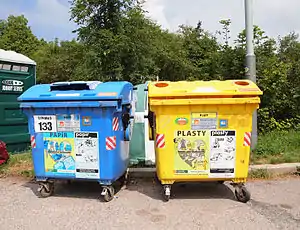
Target 12.5: Substantially reduce waste generation
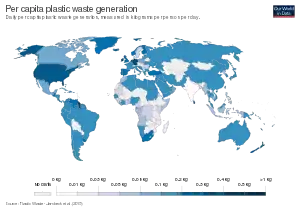
The full title of Target 12.5 is: "By 2030, substantially reduce waste generation through prevention, reduction, recycling and reuse."[1]
It has one indicator: Indicator 12.5.1 is the "National recycling rate, tons of material recycled".[13]
Every year, about one third of all food produce goes bad.[17] This is worth about $1 trillion a year. The food spoils due to consumers, and going bad during transportation.
"Minimizing waste generation and maximizing the recycling of waste is central to the concept of circular economy."[18] This indicator measures the quantity of material recycled within the country, plus the material that is exported to be recycled abroad, minus the material that countries imported to be recycled inside the country per year. These three different aspects are defined as the National Recycling Rate.[18]
Target 12.6: Encourage companies to adopt sustainable practices and sustainability reporting
The full title of Target 12.6 is: "Encourage companies, especially large and transnational companies, to adopt sustainable practices and to integrate sustainability information into their reporting cycle."[1]
It has one indicator: Indicator 12.6.1 is the "Number of companies publishing sustainability reports".[13]
This is the only indicator that focuses on monitoring private sector entities' practices. While the indicator counts only the number of private sector entities that issue sustainable reports, the custodian UN agencies promote high quality of the information reported, as well as the integration of these indicators in their annual reports and good practices.[19]
The proposed approach by the custodian agencies indicate that these reports can be stand-alone" sustainability reports or part of collective reports; not every report will be considered, this will depend on the quality of the information provided; and there will be a need to consider disclosures covering governance practices and economic, social and environmental impact.[19]
%252C_OWID.svg.png.webp)
Target 12.7: Promote sustainable public procurement practices
The full title of Target 12.7 is: "Promote public procurement practices that are sustainable, in accordance with national policies and priorities."[1]
It has one indicator: Indicator 12.7.1 is the "Degree of sustainable public procurement policies and action plan implementation".[13]
This indicator refers to the capacity of governments to procure public policies. These policies ensure economic and social development while protecting the planet and reducing the negative impacts in the environment. They need to engage with sustainable public procurement (SPP), and the capacity to measure the proportions of these efforts.[20]
Some of the limitations of this indicator are related to the different ways the countries have to measure not only SPP but also other aspects such as Green Public Procurement (GPP) and Socially Responsible Public Procurement (SRPP).[20]
Target 12.8: Promote universal understanding of sustainable lifestyles
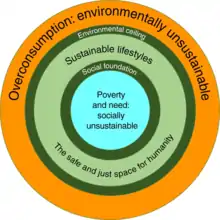
The full title of Target 12.8 is" By 2030, ensure that people everywhere have the relevant information and awareness for sustainable development and lifestyles in harmony with nature."[1]
It has one indicator: Indicator 12.8.1 is the "Extent to which (i) global citizenship education and (ii) education for sustainable development are mainstreamed in (a) national education policies; (b) curricula; (c) teacher education; and (d) student assessment".[13]
This indicator is referred to the way each country ensures Global Citizenship Education (GCED) and Education for Sustainable Development (ESD) are considered in their educational systems. One of the limitations of this indicator is related to the government self-reporting; situation addressed by UNESCO by comparing this information with alternative sources.[21]
The different aspects where GCED and ESD should be considered as priorities in the national education systems are: a) Policies, b) Curricula, c) Teacher training, d) Student assessment.[21]
Target 12.a: Support developing countries' scientific and technological capacity for sustainable consumption and production
The full title of Target 12.A is: "Support developing countries to strengthen their scientific and technological capacity to move towards more sustainable patterns of consumption and production."[1]
It has one indicator: Indicator 12.a.1 is the "Installed renewable energy-generating capacity in developing countries (in watts per capita)".[13]
The indicator is defined as the installed capacity of power plants that generate electricity from renewable energy sources divided by the total population of a country.[22] The demand for electricity is high in developing countries and often it's availability is contained.[22]
Target 12.b: Develop and implement tools to monitor sustainable tourism
The full title of Target 12.B is: "Develop and implement tools to monitor sustainable development impacts for sustainable tourism that creates jobs and promotes local culture and products."[1]
It has one indicator: Indicator 12.b.1 is the "Implementation of standard accounting tools to monitor the economic and environmental aspects of tourism sustainability".[13]
This indicator relates to the degree in which countries do implement the Tourist Satellite Account (TSA) that have to be implemented according to the Recommended Methodological Framework 2008. In addition, it relates on how countries implement the System of Environmental and Economic Accounts (SEEA) tables, which need to be implemented according the System of Economic-Environmental Accounting 2012. These two different tools are currently considered as the best more feasible way to monitor sustainable tourism.[23]
Target 12.c: Remove market distortions that encourage wasteful consumption
The full title of Target 12.C is: "Rationalize inefficient fossil-fuel subsidies that encourage wasteful consumption by removing market distortions, in accordance with national circumstances, including by restructuring taxation and phasing out those harmful subsidies, where they exist, to reflect their environmental impacts, taking fully into account the specific needs and conditions of developing countries and minimizing the possible adverse impacts on their development in a manner that protects the poor and the affected communities."[1]
It has one indicator: Indicator 12.c.1 is the "(a) Amount of fossil-fuel subsidies as a percentage of GDP; and (b) amount of fossil fuel subsidies as a proportion of total national expenditure on fossil fuels".[24]
To work in towards the reporting of this indicator at the different constituencies (Global, regional and national) it is important to consider the following sub-indicators: 1) The direct transfer of government funds, 2) Price support, 3) Tax expenditure. Is important to consider as well, while working on achieving this target, the special attention to the energy - dependent sectors and the challenges they can go through during these reform processes, especially poor households which are the ones more vulnerable to price increases.[24] "Reallocating fossil fuel subsidies to sectors that are relevant for development could give a boost to reaching the SDGs."[24]
Global fossil fuel subsidies in 2018 were $400 billion.[5]:14 This was double the estimated subsidies for renewables and is detrimental to the task of reducing global carbon dioxide emissions.[5]:14
Custodian agencies
Custodian agencies are in charge of reporting on the following indicators:[25]
- Indicators 12.1.1, 12.2.1, 12.2.2, 12.7.1 and 12.c.1: United Nations Environmental Programme (UNEP)
- Indicator 12.3.1: Food and Agriculture Organization (FAO) and United Nations Environmental Programme (UNEP)
- Indicator 12.4.1: United Nations Environment Programme (UNEP)
- Indicator 12.4.2: United Nations Environment Programme (UNEP) and Department of Economic and Social Affairs-Statistics Division (DESA/UNSD)
- Indicator 12.5.1: United Nations Environment Programme (UNEP) and the United Nations Statistics Division (UNSD)
- Indicator 12.6.1: United Nations Conference on Trade and Development (UNCTAD) and the UN Environment (United Nations Environment Programme/UNEP)
- Indicator 12.8.1: UNESCO Institute for Statistics (UNESCO-UIS) and the "UNESCO Education Sector, Division for Peace and Sustainable Development, Section of Education for Sustainable Development (UNESCO-ED/PSD/ESD)
- Indicator 12.a.1: International Renewable Energy Agency (IRENA).
- Indicator 12.b.1: United Nations World Tourism Organization (UNWTO).
Progress
An annual report is prepared by the Secretary-General of the United Nations evaluating the progress towards the Sustainable Development Goals.[5]
By 2016, 13.8% of food was lost in supply chains, this means; during the harvest, transport, storage and processing, while the case of electronic waste grew by 38% and only 20% is recyclable.
Challenges
Impacts of COVID pandemic
The COVID-19 pandemic in 2020 has offered countries an opportunity to build recovery plans that will change current trends and also change consumption and production patterns towards achieving a more sustainable future.[5]:14 The pandemic has proved that weaknesses emerge from our systems, and to meet sustainable development goals, responsibility should begin from our governments down to other civil servants.[26] It is of utmost importance that we separate environmental degradation from economic growth for the promotion of sustainable consumption. This also includes production patterns and a transition towards having a greener and an inclusive global economy.[8]
Many interferences in the global food supply chain have occurred due to the impacts of COVID-19. Due to the loss of income, many people around the world experienced due to employment disruptions, many agricultural and livestock products were discarded and destroyed, due to a surplus of these products.[27] There has also been concerns about the global trade of foods and agricultural products. Border closures, social distancing challenges, as well as interrupted air and sea transportation has caused food shortages in the retail supermarket chain. This has resulted in many consumers opting for local food supply chains, and purchasing foods and produce available regionally. However, it is unclear how these supply chains will adjust to region-specific challenges, such as weather, drought, and plague.[28] Furthermore, there has been the challenge of stockpiling, which has caused food shortages, as well as for pharmaceutical, and other personal care products.[29] This has also caused many disruptions for major supermarket chains, but under most circumstances, stockpiling is not necessary, and is actually more harmful as it leads to greater food waste, food insecurity, and negatively affects vulnerable populations, such as the elderly.[30]
Links with other SDGs and other issues
SDG 12 has targets related to SDG 2, SDG 3, SDG 4, SDG 8, SDG 9, SDG 13, SDG 14 and SDG 15.[31]
"With proper policy support, growing diversity is the foundation for dietary diversity and hence health and nutrition (SDG 2, 3), for resilience to biotic and abiotic stressors (SDG 13 and SDG 15) and should further decent employment (SDG 8) and rural livelihoods (SDG 1). Furthermore, achieving SDG 12 requires constraining industrial agriculture because of its negative impacts on other SDGs, including SDG 6, because it is the largest user of freshwater resources; SDG 2 and SDG 15 because they are chief drivers of biological diversity loss; SDG 7 because of its dependence on fossil fuels; SDG 14 because of pesticide and fertilizer run-off polluting land and water and creating dead zones in the seas; and SDG 13 because it is a major contributor to greenhouse gas emissions."[31]
Achieving SDG 12, will contribute to the achievement of the other SDGs in an direct or indirect way. Therefore, SDG 12 is an enabler to achieve other SDGs, since the policies that need to be taken in order to achieve its targets are incline to think about economic growth thinking as well on the use of the resources and how this impact in the process of poverty eradication and shared prosperity, taking us to achieve sustainable consumption and production patterns.[32]
Organizations
- One Planet network is a multi stakeholder partnership of countries and other stakeholders, that aims to support the implementation of the 10-Year Framework of Programmes on Sustainable Consumption and Production (10YFP), to increase the impact generated by the actions on the delivered on the frame of SDG 12. The partnership delivers six programmes:[33]
- United Nations Environment Programme (UNEP)
- Department of Economic and Social Affairs-Statistics Division (DESA/UNSD)
- Food and Agriculture Organization (FAO)
- United Nations World Tourism Organization (UNWTO)
- UNESCO Institute for Statistics (UNESCO-UIS)
- UNESCO Education Sector, Division for Peace and Sustainable Development, Section of Education for Sustainable Development (UNESCO-ED/PSD/ESD)[34]
- United Nations Conference on Trade and Development (UNCTAD)
- United Nations Statistics Division (UNSD).[16]
- United Nations University
References
- United Nations (2017) Resolution adopted by the General Assembly on 6 July 2017, Work of the Statistical Commission pertaining to the 2030 Agenda for Sustainable Development (A/RES/71/313)
- "sdg-tracker.org/sustainable-consumption-production".
- "Sustainable Consumption and Production: A Crucial Goal for Sustainable Development—Reflections on the Spanish SDG Implementation Report". Journal of Sustainability Research. 1 (2). 2019. doi:10.20900/jsr20190019.
- United Nations (2017) Resolution adopted by the General Assembly on 6 July 2017, Work of the Statistical Commission pertaining to the 2030 Agenda for Sustainable Development (A/RES/71/313)
- United Nations Economic and Social Council (2020) Progress towards the Sustainable Development Goals Report of the Secretary-General, High-level political forum on sustainable development, convened under the auspices of the Economic and Social Council (E/2020/57), 28 April 2020
- Martin. "Sustainable consumption and production". United Nations Sustainable Development. Retrieved 2020-09-05.
- "Goal 12: Responsible consumption and production". UNDP. Retrieved 2020-09-05.
- Environment, U. N. (2017-10-02). "GOAL 12: Sustainable consumption and production". UNEP - UN Environment Programme. Retrieved 2020-09-05.
- sdgcounting (2017-06-06). "SDG 12 Indicators". Medium. Retrieved 2020-09-05.
- "Sustainable Consumption and Production" (PDF).
- "A/CONF.216/5: A 10-Year Framework of Programmes" (PDF).
- http://www.oneplanetnetwork.org/platform-sustainable-development-goal-12 Retrieved October 15, 2018
- "SDG Indicators Metadata repository". UN Stats. Retrieved 14 September 2020.
- United Nations, Food. "Food and Agriculture Organization of the United Nations".
- "Metadata-12-04-01" (PDF). United Nations Stats. Retrieved 19 September 2020.
- "Metadata-12-04-02" (PDF). United Nations Stats. Retrieved 19 September 2020.
- United Nations. "Sustainable consumption and production". United Nations Sustainable Development. Retrieved 2020-11-26.
- "Metadata-12-05-01" (PDF). United Nations Stats. Retrieved 9 September 2020.
- "Metadata-12-06-01" (PDF). United Nations Stats. Retrieved 19 September 2020.
- "Metadata-12-07-01" (PDF). United Nations Stats. Retrieved 19 September 2020.
- "Metadata-12-08-01" (PDF). United Nations Stats. Retrieved 18 September 2020.
- "Metadata-12-0a-01" (PDF). United Nations Stats. Retrieved 18 September 2020.
- "Metadata-12-0b-01" (PDF). United Nations Stats. Retrieved 15 September 2020.
- "Metadata-12-0c-01" (PDF). United Nations Stats. Retrieved 15 September 2020.
- "United Nations (2018) Economic and Social Council, Conference of European Statisticians, Geneva," (PDF). United Nations (SDG 16) Custodian Agencies" (PDF). UNECE. Retrieved September 24, 2020.
- Environment, U. N. (2020-05-26). "COVID-19: Four Sustainable Development Goals that help future-proof global recovery". UN Environment. Retrieved 2020-09-25.
- Larue, Bruno (2020). "Labor issues and COVID‐19". Canadian Journal of Agricultural Economics. 68 (2): 231–237. doi:10.1111/cjag.12233. S2CID 218783557.
- Deaton, B. James; Deaton, Brady J. (2020). "Food security and Canada's agricultural system challenged by COVID‐19". Canadian Journal of Agricultural Economics. 68 (2): 143–149. doi:10.1111/cjag.12227. S2CID 218793789.
- "Stockpiling is in full effect, but it's not the answer to surviving a coronavirus outbreak". nationalpost. Retrieved 2020-11-26.
- Hobbs, Jill E. (2020). "Food supply chains during the COVID‐19 pandemic". Canadian Journal of Agricultural Economics. 68 (2): 171–176. doi:10.1111/cjag.12237. S2CID 218786901.
- "Advancing the 2030 Agenda: Interlinkages and Common Themes at the HLPF 2018" (PDF). UN Sustainable Development. p. 30. Retrieved 15 September 2020.
- "One World Planet". UN Environment. Retrieved 15 September 2020.
- "Who we are". One Planet Netowrk. Retrieved 15 September 2020.
- "Metadata-12-08-01" (PDF). United Nations Stats. Retrieved 18 September 2020.
